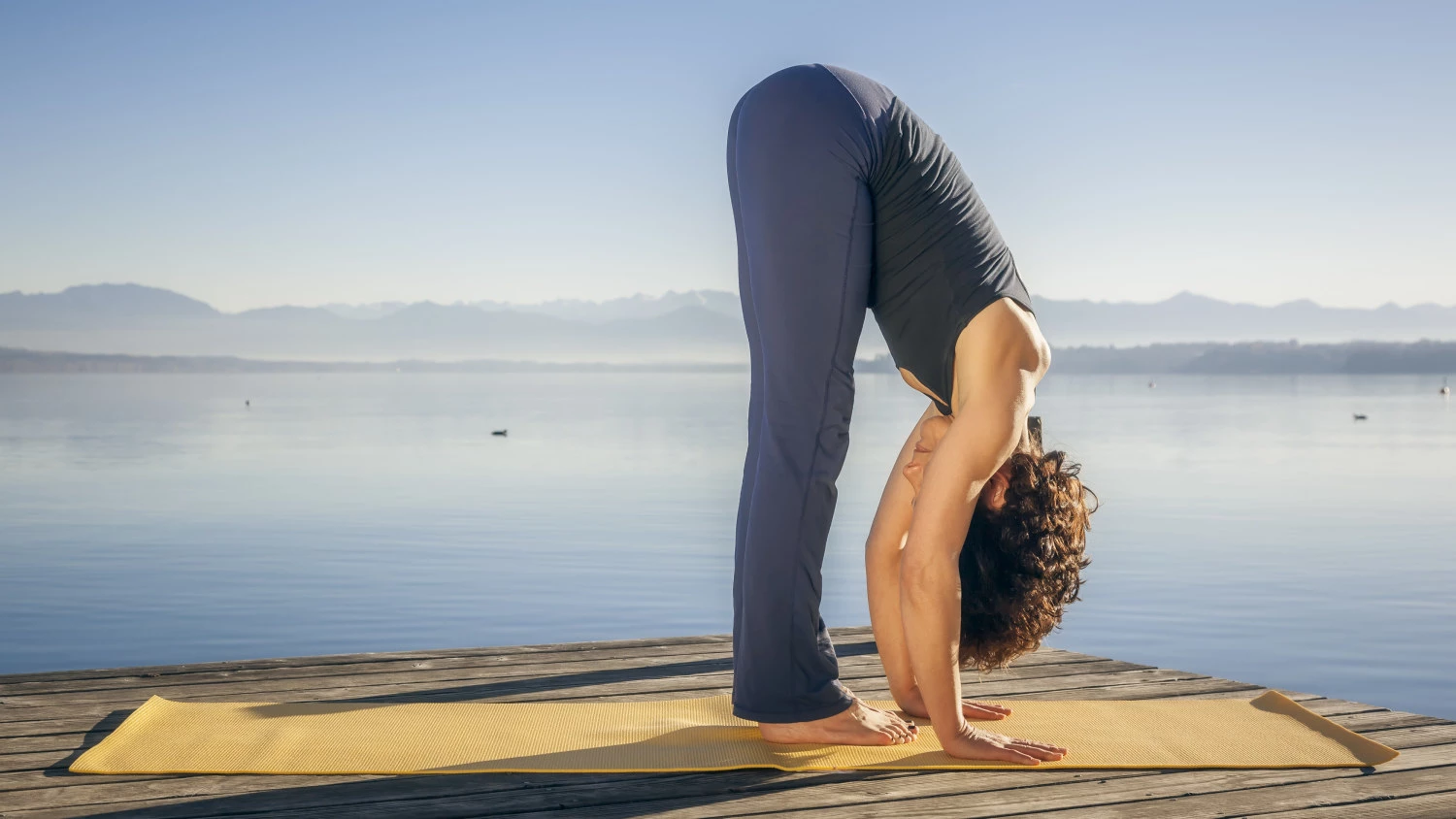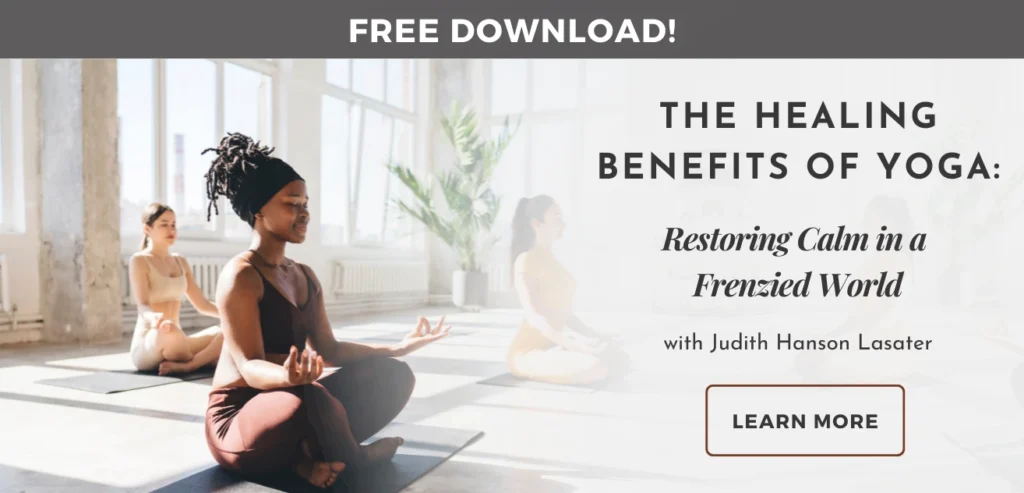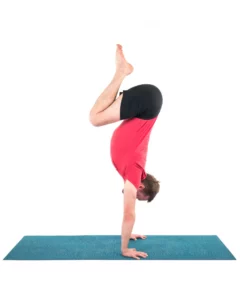Uttanasana: Expand Your Breath

We practice yoga asanas (poses) to free the body so that it can more easily take in, let go of, and absorb the energy of the breath. In Patanjali’s Eight Limbs of Yoga, the practice of asana (i.e. the third limb of yoga) immediately precedes Pranayama, expansion of the breath. The practice of yoga asana relaxes and mobilizes the body’s structures. This allows us to receive and expel the breath with greater ease. Even though all asanas support deeper breathing, some do this with more specificity. Forward bending poses, including Uttanasana, can help us expand the lungs and diaphragm for deeper breathing.
Benefits of Uttanasana
Quite often, we think of chest- and heart-opening poses as lung-supporting poses, and this is true. However, forward bending poses like Uttanasana play an important role in deepening the breath as well.
Forward bending poses physically support the natural movements of your lungs as you breathe. The back body expansion inherent in any forward bending position supports the natural rotation of your lungs as you breathe.
When we inhale, the lungs naturally expand outward, away from each other. The outer sides of the lungs rotate forward into the sides of the ribcage. When we exhale, the lungs move back toward one another and settle into the back.
Allowing your body to oscillate—up and down, outward and inward—in response to the internal movement of your breath supports free respiration.
Precautions for Forward Bends
In any forward bend, it’s important to make sure that your pelvis bends forward along with your spine. In Uttanasana, your pelvis should tip forward so that the upper body “pours” out of the pelvic bowl and your ischial tuberosities (sit bones) are the apex of your pose. It’s important to avoid bending from the waist. Bending from the waist can compromise the intervertebral discs of the lumbar area.
If your pelvis does not easily tip forward in a forward bend, it is likely because your hamstrings and/or abductors are tight. However, most people can do this pose safely—even if these muscles are tight. In that case, you can bend the knees enough to ensure that the pelvis tips forward. Remember that Uttanasana is primarily a forward fold. It is the forward movement of pelvis and spine and the rooting of your legs—not the degree of bend in the knees—that are most vital to the spirit of the pose.
Practice Steps for Uttanasana
- Begin by standing on a nonskid mat with your feet parallel and hips-width apart. As you stand, plant your feet into the floor. Imagine your feet growing roots.
- Place your hands on your waist and tip the top of your pelvis slightly forward. On an exhalation relax your head and neck forward, and bend your knees as you fold your pelvis and torso forward together toward the floor, allowing your spine to round on the way down.
- When you reach the bottom of your forward bend, release your hands from your hips and let your arms hang. Let your hands rest on the floor if they can reach. Relax your neck so that the back of it is long and the top of your head points toward the floor. You can relax into the pose with your knees bent as they are, or you can begin to straighten them gradually, only straightening so far as you can maintain your forward pelvic tilt.
- Breathe deeply into your back body. As you inhale, let your breath expand your entire back body. You may feel the torso lift up, away from the floor, as you inhale. Allow this movement. Relax your abdomen and imagine drawing your breath all the way down into your roots. As you exhale, feel your torso settling forward again, letting go of tension and effort.
- Take five to ten breaths. Then on an inhalation bend your knees to about 90 degrees, root your feet and lift your torso enough so that you are about halfway toward standing. Rest your elbows on your knees. Stay here for a few breaths before pressing down through your feet and coming up to standing. Resting at the halfway point prevents the dizziness that some people feel when they return to an upright position after practicing Uttanasana.
Let your pose grow out of the breath, rather than making the breath conform to the pose. As you inhale, you may feel your back body expand outward and your shoulders and arms round forward slightly on the inhalation. As you exhale, feel your shoulder blades roll back toward the center of your back.
Contraindications for Standing Forward Bend
- If you have diagnosed degenerative disc disease or uncontrolled high blood pressure, Uttanasana may not be appropriate for you at this time. In the second and third trimesters of pregnancy, try widening your stance to accommodate your growing belly.
- For people with osteoporosis, bending forward with a flexed spine is contraindicated. Flexing the spine can be avoided by tilting forward from the pelvis only with a straight spine. However, beginning yoga students will need the guidance of an experienced yoga teacher to develop the awareness needed for this action, so if you have osteoporosis, be sure to seek the guidance of a yoga teacher, before trying this pose on your own. And of course, as always, consult with your doctor before starting any new form of physical activity and exercise.
Also, read...
Cat-Cow Pose (Marjaryasana-Bitilasana)
2 Restorative Yoga Poses to Calm Your Body and Mind
Related courses

Charlotte Bell began practicing yoga in 1982 and began teaching in 1986. She was certified by B.K.S. Iyengar in 1989 following a trip to Pune. In 1986, she began practicing Insight Meditation with her mentors Pujari and Abhilasha Keays. Her asana classes blend mindfulness with physical movement. Charlotte writes a column for Catalyst Magazine and serves as editor for Yoga U Online. She is the author of two books: Mindful Yoga, Mindful Life, and Yoga for Meditators, both published by Rodmell Press. She also edits Hugger Mugger Yoga Products’ blog and is a founding board member for GreenTREE Yoga, a non-profit that brings yoga to underserved populations. A lifelong musician, she plays oboe and English horn in the Salt Lake Symphony and the folk sextet Red Rock Rondo whose 2010 PBS music special won two Emmys.



